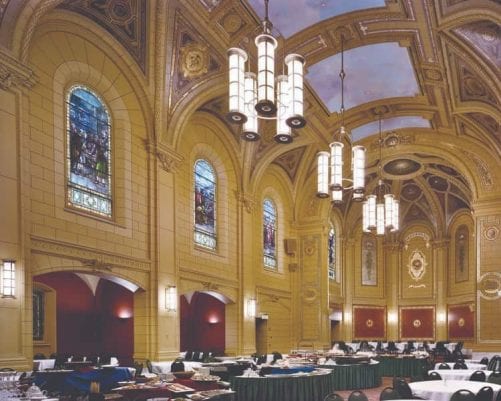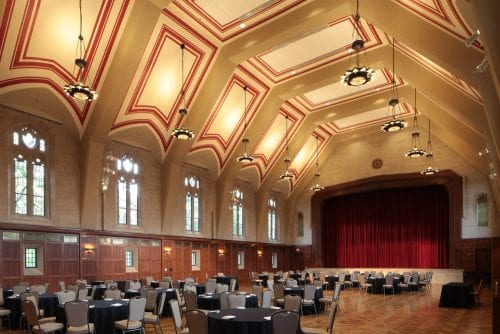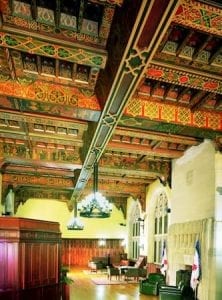
MIT Barker Library Dome - Neoclassical Architecture
Process
Maintaining the historic charm of a college campus is done in three elementary steps: First, it is important to understand the basic styles of architecture and their key elements in order to determine which was used in the design and construction of the space. Second, determine which architectural features on campus are in need of restoration, conservation, or repair, paying particular attention to those characteristic elements of the style. Sometimes historic restoration consultants are brought in to help determine what actually needs to be done. This may involve historic paint investigations, plaster surveys and building assessments. Lastly, conserve, restore, and replicate those elements as needed utilizing a team with the required qualifications and skill.Considerations
During the maintenance process, facility managers need to consider the following: the architectural style of the campus, the original architect, and the purpose of the building that is being maintained. To preserve the unique charm of a historic campus, it’s important to identify the design elements commonly found in buildings of that particular architectural style and the original architect’s work. Perhaps a specific type of paint is characteristic of the architectural style, or the architect who designed the campus building was known to leverage ornamental plaster in a unique way. In addition, facility managers need to contemplate the original purpose of the building and whether the goal is to maintain or repurpose it. For example, restoration of a sacred building on campus, like a chapel, will vary greatly compared to the maintenance of secular buildings.History of Architectural Styles
Below is a quick primer on the history of architectural styles, which influence conservation, restoration, and preservation services. The development of architectural styles employed today began in 850 B.C. with Classical Greek and Roman architecture. Following this original style, Gothic architecture began in the 12th century in France, which constituted a very different aesthetic. This was closely followed by the Renaissance, Baroque, and Neoclassic styles, all of which reverted in some way back to the Classical style. The Victorian style came soon after in 1840 with the reign of Queen Victoria. Since then, other styles have emerged such as the Federal and Colonial styles as well as some modern.Collegiate Architectural Styles in the US
The history of collegiate architectural styles developed in accordance with those aforementioned. In the US, Harvard was the very first university established in 1638 and, while constituted from a mix of styles, is predominantly Georgian (Federalist). Yale University, Princeton University, and the College of William & Mary followed and were modeled predominately after the Gothic and Renaissance styles of Scottish and English institutions.
University of Michigan -Hill Auditorium
Maintaining Historic College Campuses
Today, colleges are found in Gothic, Renaissance, Neoclassic, Victorian, and other historic styles and it is the duty of the people to maintain their historic elegance. Here at John Canning & Co., we hold that every historic building is worthy of conservation and restoration, and we facilitate the means to achieve this end.Historic Restoration of Some Main Architectural Styles
Gothic
Perhaps the most common style utilized today on college campuses is the Gothic style, which was famously brought to attention by architect James Gamble Rogers at Yale University in the early 20th Century, and spread rapidly by other collegiate architects like Rudolph Weaver.
Gothic buildings are mostly horizontal in stature, contrasted with one or more high towers to serve as an exclamation. Many elements of the Gothic Sterling Memorial Library at Yale University were carefully conserved and restored by John Canning & Co. including, woodwork, plaster, decorative finishes, murals, and the magnificent vaulted ceiling.
John Canning & Co. understood the traditional style of the building and its key elements through historic analyzation, determined what needed restoration, and executed that restoration paying close attention to that of the vaulted ceiling which is a defining feature of the Gothic style. The Manuscripts and Archives Library, located within the same building, was conserved in a similar manner, following the three-step process mentioned above.
Yale University
Renaissance
Following the Gothic, the Renaissance style adopted more Classical elements such as columns, arches, domes, and detailed decoration surrounding symmetrical windows and doors.
The Culinary Institute of America in Hyde Park, NY, originally a Jesuit chapel, was built and restored in the Renaissance Revival style. The company’s work included extensive decorative detail work which is characteristic of the Renaissance style including historic paint analysis, paint exposure, pattern documentation, gilding, and wood restoration.

Culinary Institute of America
Neoclassic
Neoclassic architecture is another Classical revival type. It began in the mid-18th century in Italy and became particularly popular in France.
Neoclassicism in collegiate institutions came to the US with Thomas Jefferson’s design of the Central Ground and Rotunda at the University of Virginia. This was the first public university in the US and his selection of the Neoclassic style set a president for American universities going forward.
Garrett Hall at the University of Virginia and many other collegiate buildings in the US were built in this style including Gordon Hall at the Harvard Medical School, Barker Library at Building 10 of MIT, and Hill Auditorium at the University of Michigan.
John Canning & Co. was privileged to perform detailed restoration on each of these. The general scope included decorative painting, gilding, glazing, installing structural supports, ornamental plaster, and much more.
At the Massachusetts Institute of Technology, we performed a number of restoration jobs on the Grand Lobby, Loggias, and the Great Rotunda of the Barker Library. We reattached the vaulted ceiling of Garrett Hall as well as designed and installed its decorative paint scheme inspired by other schemes from that time period.
The Harvard Medical School project involved exterior restoration work for Gordan Hall, Tosteson Medical Education Center Façade, and the Laboratory for Human Reproduction and Reproductive Biology that included mockups, faux finish work of masonry as well as tinting patches and Dutchmen to match the existing.

University of Virginia -Garrett Hall Interior Restoration
Victorian
The Victorian is a British style mostly found in homes but also used in theaters and collegiate buildings. It can be spotted by steeply pitched roofs, bay windows, wraparound porches, round or octagonal towers, grand staircases, high ceilings, and intricately carved wood paneling.
In the US, the Victorian is often woven into the Federal or Colonial style of early America. John Canning & Co. painted the red and white ceiling panels in Alumni Hall at the University of Indiana designed in this Victorian Revival Style.

Alumni Hall Indiana University

















